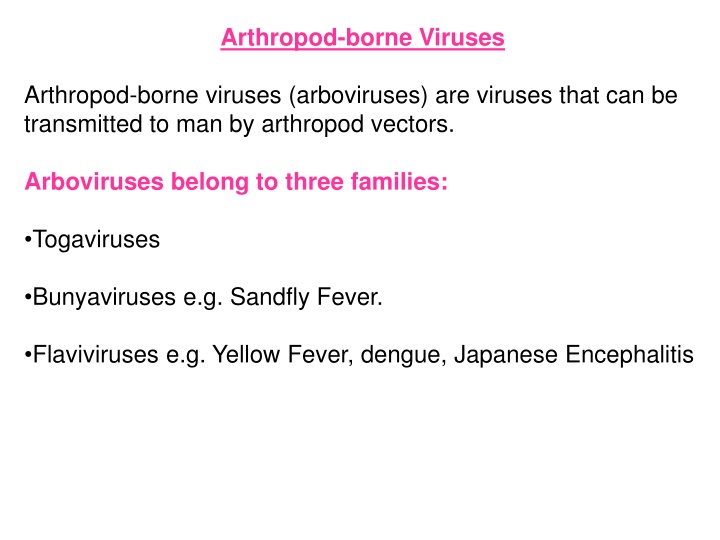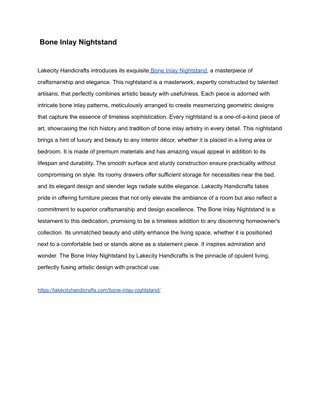Arboviruses and Their Impact
Arboviruses, transmitted by arthropod vectors, pose a threat to humans. Learn about transmission cycles, arthropod vectors, diseases caused, diagnosis methods, and prevention strategies. Explore specific examples like Yellow Fever and Japanese Encephalitis.
Download Presentation

Please find below an Image/Link to download the presentation.
The content on the website is provided AS IS for your information and personal use only. It may not be sold, licensed, or shared on other websites without obtaining consent from the author.If you encounter any issues during the download, it is possible that the publisher has removed the file from their server.
You are allowed to download the files provided on this website for personal or commercial use, subject to the condition that they are used lawfully. All files are the property of their respective owners.
The content on the website is provided AS IS for your information and personal use only. It may not be sold, licensed, or shared on other websites without obtaining consent from the author.
E N D
Presentation Transcript
Arthropod-borne Viruses Arthropod-borne viruses (arboviruses) are viruses that can be transmitted to man by arthropod vectors. Arboviruses belong to three families: Togaviruses Bunyaviruses e.g. Sandfly Fever. Flaviviruses e.g. Yellow Fever, dengue, Japanese Encephalitis
Transmission Cycles Man - arthropod -man e.g. dengue, urban yellow fever. Reservoir may be in either man or arthropod vector. Animal - arthropod vector - man e.g. Japanese encephalitis, jungle yellow fever. The reservoir is in an animal. The virus is maintained in nature in a transmission cycle involving the arthropod vector and animal. Man becomes infected incidentally. Both cycles may be seen with some arboviruses such as yellow fever.
Arthropod Vectors Mosquitoes Japanese encephalitis, dengue, yellow fever. Ticks Crimean-Congo haemorrhagic fever. Sandflies Sicilian sandfly fever, Rift valley fever. Animal Reservoirs In many cases, the actual reservoir is not known. The following animals are implicated as reservoirs Birds Japanese encephalitis. Pigs Japanese encephalitis Monkeys Yellow Fever Rodents Russian Spring-Summer encephalitis
Diseases Caused Fever and rash - this is usually a non-specific illness resembling a number of other viral illnesses such as influenza, rubella, and enterovirus infections. The patients may go on to develop encephalitis or haemorrhagic fever. Encephalitis - e.g. Japanese encephalitis Haemorrhagic fever - e.g. yellow fever, dengue, Crimean- Congo haemorrhagic fever.
Diagnosis Serology - usually used to make a diagnosis of arbovirus infections. Culture - a number of cell lines may be used, including mosquito cell lines. However, it is rarely carried out. Direct detection tests - e.g detection of antigen and nucleic acids are available.
Prevention Surveillance - of disease and vector populations Control of vector - pesticides, elimination of breeding grounds Personal protection - screening of houses, bed nets, insect Repellants Vaccination - available for a number of arboviral infections e.g. Yellow fever, Japanese encephalitis, Russian tick-borne encephalitis
1- Yellow Fever Flavivirus, mainly found in West Africa and South America Yellow fever occurs in 2 major forms: Urban Jungle yellow fever. In the Jungle YF, the natural reservoir of the disease in a cycle involving nonhuman primates and forest mosquitoes. Man may become incidentally infected on venturing into jungle areas. The urban form is transmitted between humans by the Aedes aegypti mosquito Classically Yellow Fever presents with chills, fever, and headache. Generalized maligns and complaints.
Some patients may experience an asymptomatic infection or a mild undifferentiated febrile illness. After a period of 3 to 4 days, the more severely ill patients with a classical YF course will develop bradycardia (Faget's sign), jaundice, and haemorrhagic manifestations. 50% of patients with frank YF will develop fatal disease characterized by severe haemorrhagic manifestations, oliguria and hypotension. Diagnosis is usually made by serology. There is no specific antiviral treatment. An effective live attenuated vaccine is available against yellow fever and is used for persons living in or traveling to endemic areas.
2- Dengue (1) Prior to 1953, infections caused by dengue viruses were rarely fatal. In recent years however, a sever and often fetal form of dengue has developed which affects mainly infants and young children. This form of dengue virus referred to as Dengue Haemorrhagic Fever (DHV), has become a major form of sever illness and death in children in tropical South-East Asian countries. Dengue is the biggest arbovirus problem in the world today with over 2 million cases per year. Dengue is found in parts of Asia, Africa and the Caribbean and S America. Flavivirus, 4 serotypes, transmitted by Aedes mosquitoes which inhabit in water-filled containers. .
Human infections arise from a human-mosquitoe-human cycle. In early stages: Fever, rash, headache, and pains in the muscles and joints. The fever is more marked than the classic form of dengue, and there is bleeding into the skin and from the mucous membranes. There is also abdominal pain and liver enlargement. About 25% of children show reduced platelets leading to sever haemorrhage. There is no specific treatment for Dengue Haemorrhagic Fever, because the reasons are not fully understood
Classically, after that dengue presents with a high fever, lymphadenopathy, myalgia, bone and joint pains, headache, and a maculopapular rash. Diagnosis is made by serology. No specific antiviral therapy is available. Prevention of dengue in endemic areas depends on mosquito eradication. The population should remove all containers from their premises which may serve as vessels for egg deposition. A live attenuated vaccine is being tried in Thailand with encouraging results.
POXVIRUSES INTRODUCTION A range of pox viruses cause febrile illnesses in man and animals with a prominent vesicular rash. The most prominent of them was smallpox virus (variola) which caused a severe disease in man but which has now been eliminated by intensive international vaccination. Current interest in poxviruses centers around their possible use as vaccine vectors. Double stranded of DNA, brick-shape or oval particles with complex symmetry. The Poxviruses are the largest of viruses. They are called so because of the pox (rash of pus-filled blisters, known as pocks) produced in response to infection. The Poxvirus family contains the following medically important viruses: Viruses of the Orthopox genus (vaccinia, smallpox, and monkeypox and other animal poxviruses). Unclassified poxviruses. True pox viruses are antigenically rather similar, so that infection by one elicits immune protection against the others.
Laboratory diagnosis of pox viruses: Specimen must be collected with great care and sent to the Virology lab with facilities for testing dangerous pathogens. Such specimen should include material from pustules spread on a slide, collected on swabs, or placed directly in a sterile airtight container. May be undertaken by electron microscopy of negatively stained vesicle fluid or lesion material. Some pox viruses can be cultured on a special membrane of chick embryos, where they form pocks, and some can be isolated by cell-culture.
HUMAN INFECTION variola In 1979 the WHO declared the eradication of smallpox through the world after a successful international vaccination campaign. All vaccines against the disease have now been discontinued. Infection with smallpox virus (variola) produced a sever and fetal disease. Vaccinia a virus strain which has been used for immunization against smallpox and now being used to immunize against other orthopox viruses including monkeypox virus. Rarely causes diseases in human. It's origins are not known but it seems to be a genetically distinct type of pox virus which grows readily in a variety of hosts.
Monkeypox Human infection with monkeypox viruses have been reported from Central and West Africa in persons had contact with infected wild monkeys. The virus causes sever and fetal generalized disease (undistinguished from smallpox), with fever, pain, and rash. Pustules form on the conjunctiva and mucous membranes of the mouth. It is not easy for this disease to spread from one person to person. Cowpox Is acquired by humans usually by milking cows; it then manifests as ulcerative lesions (sometimes called "milkers nodules") on the hands of dairy workers. It was noted to protect against smallpox and was used by Jenner as a vaccine strain to protect persons against smallpox. Despite its name, rodents are the main reservoir of cowpox; it spreads secondarily to cows and domestic cats.
Viral Zoonosis Definition Zooneses are diseases of vertebrate animals that can be transmitted to man: either directly or indirectly through an insect vector. When an insect vector is involved, the disease is also known as an arboviral disease. However, not all arboviral diseases are zoonosis: where the transmission cycle takes place exclusively between insect vector and human e.g. dengue and urban yellow fever. Examples of viral zoonoses that can be transmitted to man directly include rabies, lassa and ebola fevers.
Rabies Virus Member of the Lyassavirus. family Rhabdovirus and genus Lyssavirus. ssRNA enveloped virus, characteristic bullet-shaped appearance with helical capsid symmetry. Exceedingly wide range of hosts. It is surrounded by an envelope which has short protrusions. Wild rabies virus is often referred to as "street virus".
Epidemiology Rabies is a zoonosis which is prevalent in wildlife. The main animals involved differs from continent to continent. fox, bats wolf, dog dog dog, mongoose foxes, raccoons, insectivorous bats dog, vampire bats Europe Middle East Asia Africa N America S America
Laboratory Diagnosis Histopathology - Negri bodies are pathognomonic of rabies. However, Negri bodies are only present in 71% of cases. Rapid virus antigen detection - in recent years, virus antigen detection by IF had become widely used. Virus cultivation - The most definitive means of diagnosis is by virus cultivation from saliva and infected tissue. Serology - In late stages, a diagnosis of rabies can usually be confirmed by serological tests, circulating antibodies appear slowly in the course of infection but they are usually present by the time of onset of clinical symptoms.























